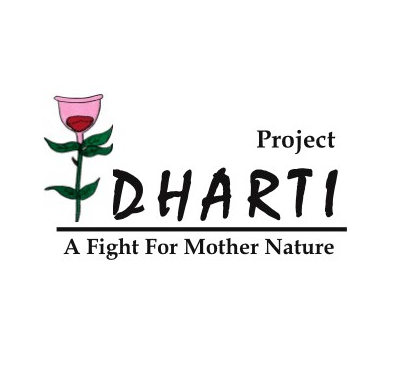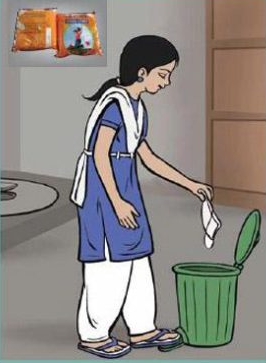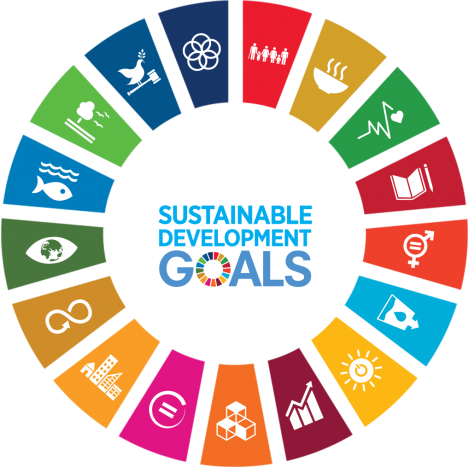Project DHARTI
The project DHARTI stands for Degradable Hygiene Management and Recycling Training Initiative. Through the project, the organisation aims to impart awareness and training sessions related to menstrual cycle management and waste management, increase awareness about menstruation and protect the environment, with a focus on empowering women.
How do Menstrual Cups help protect the environment?
Single-use ‘disposable’ period products when disposed off, form the fifth biggest source of plastic in marine life. They block sewers, take over 500 years to decompose in land-fill and also create air pollution if burned. In a lifetime, each woman uses pads and tampons which can approximately fill two minibuses of waste. In comparison, one menstrual cup requires only 15 grams of silicone to be made and uses half a cup of water to wash each month. Washable pads or clothes require 14 litres of water each month to wash.
- The environmental impact of a menstrual cup is less than 1.5% of the impact of tampons or pads
- Using menstrual cups consumes 16 times less carbon, saving 7 kg CO2 over a year
- If just 10% of the 60 million women in the USA who menstruate use menstrual cups, the annual carbon saving would be the equivalent to 42,000 metric tons CO2
Why PROJECT DHARTI?
According to the Brookings Institution Study, India produces 277.1 million tons of solid waste annually which includes a variety of waste. Approximately, 15,722 tons of plastic waste is generated in India. The Ministry of Environment, Forest and Climate change had estimated that out of total municipal waste generated in India, only 75-80 percent of it gets collected and out of the total collected, only 22-28 percent gets processed and treated.
A large proportion of this untreated waste gets dumped into landfills indiscriminately, block drains and sewerage systems. This leads to a number of respiratory problems and heart diseases. Extended Producer Responsibility (EPR) and the E-Waste (Management) Rules, 2016 need to be implemented strictly to avoid disasters due to mismanagement of e-waste.
Project Dharti Vision & Mission
- The initiative has been designed pragmatically with a social mobilisation in which the change agents movement campaign has been formulated.
- Concept of adopting a menstrual cup has been programmed as it is an eco-friendly and reusable option unlike plastic sanitary pads and tampons that take years to degrade and create tons of plastic waste.
- The project aims to help women economically, increase environmental justice and enhance key sustainable development goals. Hence, it can augment the efficiency of NRLM (National Rural Livelihood Mission) in which maternal, adolescent and child health have been designated as major objectives.
- The project also provides counselling and training about how to use a menstrual cup and closely works with NRLM (National Rural Livelihood Mission).
- With dedicated initiatives, we have made India’s first menstrual cup user rural S.H.G. (Self Help Group) through our Change Agents Movement campaign which has been running successfully in the country.

MENSTRUAL HYGIENE AND HUMAN RIGHTS

The right to work
Women, at times, compromise on their right to work due to a lack of maintaining appropriate period hygiene and medicine affecting their workplace performance. Menstruation taboos may lead to job discrimination for women, thereby affecting the equality at work.
Insufficient Menstrual Waste Disposal Mechanisms
The Indian government has been encouraging the use of mini-incinerators in schools and women’s sanitary complexes to burn sanitary pads as soon as the disposal to deal with menstrual waste. The Nirmal Bharat Abhiyan (NBA) released guidelines to this effect in December 2013. The principal design of the more recent Swachh Bharat Swachh Vidyalaya mission involves at least one incinerator in the girl’s bathroom.
Unfortunately, there are no plans in place to monitor the pollution from these incinerators. There are also no credible peer-reviewed reports claiming that emissions from these incinerators have no negative impact on public health. Furthermore, biodegradable materials in disposable sheets, such as cellulose, wood pulp, and cotton, often contain furans and dioxins. These are among the most lethal toxins known to science, and are extremely toxic.
This waste management solution is also not economically sustainable as the operational cost of incinerating one sanitary napkin costs a lot. According to the WHO, when plastic polymer products, such as disposable pads, are burned at lower temperatures, they usually release asphyxiant. As a result, it is recommended that health-related waste be incinerated only at temperatures above 800 degrees. Even so, there are concerns about whether sanitary napkin incineration is the best option or not.
Though there has been a marked improvement in awareness. A report by the National Institute of Public Cooperation and Child Development, funded by ICMR, found that the awareness of adolescent girls about menstruation till its onset had gone up from 29.4 percent in 2007 to 72.6 percent in 2012, while knowledge on washing and reusing cloth had gone up from 57.6 to 82.5 percent. There were no recent figures available. The ICMR is currently conducting a study to find cost-effective menstrual hygiene solutions for schoolgirls, like the use of biodegradable sanitary napkins or reusable menstrual cups.
SDGs and Project DHARTI
Sustainable Development Goals
The Sustainable Goals with its indicators are a set of 17 goals and 169 targets, designed to be the blueprint for the sustainable development in future. The goals were set up in 2015 by the U.N. General Assembly and are to be achieved by 2030. Through its goals and targets, the SDG framework tries to cover almost each and every aspect of human and social development. For its achievement, the framework calls for actions at each level of government, from global to national, regional and local levels. For keeping a track of the development made for every single goal, the SDGs also provide a measurable indicator framework, which can help in knowing the actual amount of work done on ground towards the achievement of a particular goal.
Project DHARTI and the SDGs
If implemented through the government schemes and policies, project DHARTI could help the government fulfil a number of Sustainable Development Goals accepted globally. The project targets a wide range of human development schemes that covers the topic of women reproductive health, sanitation and hygiene, women education and empowerment. Apart from these, the project also encompasses certain community targets of protecting the environment, trying to avert a possible environmental disaster in the next 20 years.
GOAL 3: Ensure Healthy Lives and Promote Well-Being for all at all Ages
Target 3.7: By 2030, ensure universal access to sexual and reproductive health-care services, including for family planning, information and education, and the integration of reproductive health into national strategies and programmes.
- The target 3.7 clearly states to ensure access to reproductive healthcare services to all and also the integration of the same into the national programmes and policies by 2030
- Lal Sakhi’s initiative of promoting the use of environment friendly menstrual cup as an absorbent during menstruation, could be the easiest, cheapest and the most user-friendly solution to ensure the access of reproductive healthcare services to all.
- The government agencies would be facing the challenge of delivering them again and again to the same beneficiary as they could be used only once. Whereas, a single menstrual cup could last up to a period of 10 years and could be used multiple times.
GOAL 6: Ensure Availability and Sustainable Management of Water and Sanitation for All
Target 6.2: By 2030, achieve access to adequate and equitable sanitation and hygiene for all and end open defecation, paying special attention to the needs of women and girls and those in vulnerable situations.
- The call for hygiene under this goal also includes the menstrual hygiene of women and girls. A majority of women get infected from a number of diseases like reproductive tract infections and other issues due to usage of raw cloth or unhealthy absorbents.
- Women and girls also get diseases due to non-availability of proper sanitation facilities during the menstrual cycle like soaps, hand washes.
- A menstrual cup, which is made up of silicon, contains no added perfumes or chemicals, is very much a human body friendly instrument. The cup is also leakage proof and can save from a number of infections which occur due to extended use of wet cloth or absorbent.
- The menstrual cup also does not require the availability of any soaps for its use.
GOAL 12: Ensure Sustainable Consumption and Production Patterns
Target 12.5: By 2030, we aim at reducing waste generation through prevention, reduction, recycling and reuse.
- A woman on an average uses 8 to 10 pads during her one menstrual cycle. And one pad takes around 500 to 800 years to get disposed of/degrade. So, in total, it makes 12000-15000 pads used by a woman in her reproductive years. A cup can last up to 10 years.
- Moreover, the menstrual cup is made up of silicon, which is a naturally occurring element, and is very easily degradable.
- Thus, in the long run, it can save the environment by reducing huge amounts of non-biodegradable waste produced.
- Our environment is already under tremendous stress generated by humans, an addition of more plastic waste can lead to a possible environmental disaster in future, which the cup could very easily avert.







